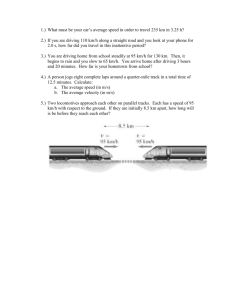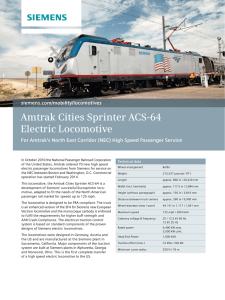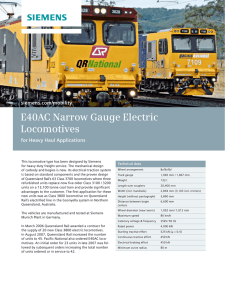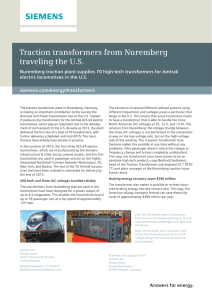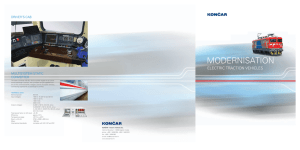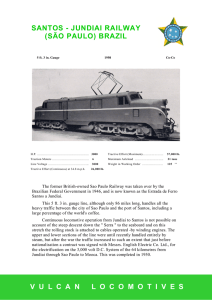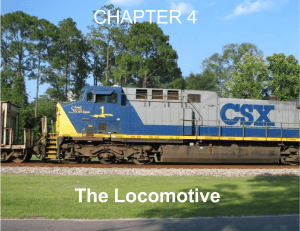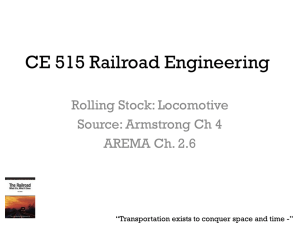intro contents.indd - Rail Knowledge Bank
advertisement
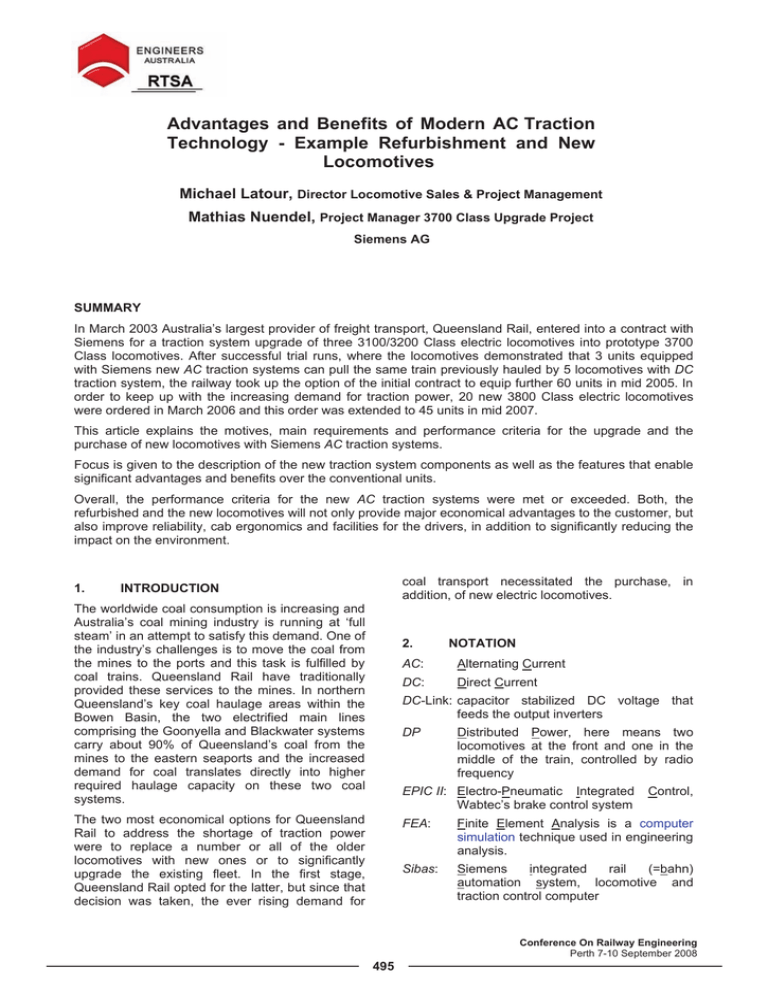
Advantages Advantages and Benefits and Benefits Advantages of Modern of Modern and ACBenefits Traction AC Traction of Modern AC Traction Technology Technology - Example - Example Technology Refurbishment Refurbishment - Example and and New Refurbishment New and New Locomotives Locomotives Locomotives <Michael <Michael Latour, Latour, Director Director Locomotive <Michael Locomotive Sales Latour, & Sales Project Director & Project Management> Locomotive Management> Sales & Project Manage <Mathias <Mathias Nuendel, Nuendel, ProjectProject Manager <Mathias Manager 3700Nuendel, Class 3700 Upgrade Class Project Upgrade Project> Manager Project> 3700 Class Upgrade Proj < Siemens < Siemens AG> AG> SUMMARY SUMMARY < Siemens AG> SUMMARY In March In March 2003 Australia’s 2003 Australia’s largest largest provider In March provider of2003 freight Australia’s of freight transport, transport, largest Queensland provider Queensland Rail, of freight entered Rail,transport, entered into a contract into Queensland a contract with Rail, withentered into a Siemens Siemens for a traction for a traction systemsystem upgrade Siemens upgrade of three for aof3100/3200 traction three 3100/3200 system Classupgrade electric Class electric of locomotives threelocomotives 3100/3200 into prototype Class into prototype electric 3700 locomotives 3700 into p Class locomotives. Class locomotives. After successful After successful Class triallocomotives. runs, trialwhere runs, After where the locomotives successful the locomotives trial demonstrated runs, demonstrated where that the3 locomotives units that 3equipped units demonstrated equipped that 3 u with Siemens with Siemens new ACnew traction AC traction systems withsystems Siemens can pullcan new thepull same ACthe traction train samepreviously systems train previously can hauled pullhauled by the5 same locomotives by 5train locomotives previously with DCwith hauled DC by 5 locomo tractiontraction system,system, the railway the railway took up traction took the up option system, the of option the theinitial of railway thecontract initial tookcontract up to the equip option tofurther equip of the further 60 units initial 60incontract units mid 2005. in to midequip In 2005. further In 60 units in order toorder keeptoup keep withupthewith increasing the order increasing demand to keep demand for uptraction with for the traction power, increasing power, 20 new demand 203800 newClass for 3800 traction electric Classpower, electric locomotives 20locomotives new 3800 Class electri were ordered were ordered in March in 2006 Marchand 2006 this were and order ordered thiswas order extended in was March extended 2006 to 45 and units to 45 this inunits mid order 2007. inwas mid extended 2007. to 45 units in mid 2007. This article This article explains explains the motives, the motives, This mainarticle requirements mainexplains requirements and the motives, performance and performance maincriteria requirements criteria for thefor and upgrade the performance upgrade and theand criteria the for the upg purchase purchase of new of locomotives new locomotives with purchase Siemens with Siemens AC of new traction AC locomotives traction systems. systems. with Siemens AC traction systems. Focus is Focus givenistogiven the description to the description ofFocus the new ofis the given traction new to traction the system description system components components of the as new well traction as aswell thesystem features as the components features that enable thatas enable well as the feature significant significant advantages advantages and benefits and significant benefits over the over conventional advantages the conventional and units. benefits units.over the conventional units. Overall,Overall, the performance the performance criteriaOverall, criteria for thefor the new the performance AC new traction AC traction criteria systems systems forwere the new met wereor AC met exceeded. traction or exceeded. systems Both, the Both, were the met or exceed refurbished refurbished and theand newthe locomotives new locomotives refurbished will not will only and not provide the only new provide major locomotives economical major economical will not advantages onlyadvantages provide to the major customer, to the economical customer, but advantages but to the also improve also improve reliability, reliability, cab ergonomics cabalso ergonomics improve and facilities and reliability, facilities for the cabfor drivers, ergonomics the drivers, in addition and in addition facilities to significantly to forsignificantly the drivers, reducing reducing inthe addition theto significantly impact impact on the environment. on the environment. impact on the environment. coal transport coal transport necessitated necessitated thecoal purchase, the transport purchase, in necessitated in the INTRODUCTION addition, addition, of new of electric new electric locomotives. locomotives. addition, of new electric locomotives. The worldwide The worldwide coal consumption coal consumption isThe increasing worldwide is increasing and coal and consumption is increasing and Australia’s Australia’s coal mining coal mining industryindustry isAustralia’s running is running atcoal ‘fullmining at ‘full industry is running at ‘full steam’ steam’ in an attempt in an attempt to satisfy to satisfy this steam’ demand. this in demand. an One attempt of Onetoofsatisfy this demand. One of 2. 2.NOTATION NOTATION 2. NOTATION the industry’s the industry’s challenges challenges is to move isthe to the move industry’s coalthe from coal challenges from is to move the coal from the mines the to mines the ports to theand ports this and task the thisis mines task fulfilled is to fulfilled the by ports byAC: and this task is Alternating fulfilled by Current AC: Alternating Current AC: Alternating Current coal trains. coal trains. Queensland Queensland Rail have coal Rail traditionally have trains. traditionally Queensland Rail have traditionally DC: DC: Direct Current DC: Direct Current Direct Current provided provided these services these services to the mines. to provided the mines. In northern these In northern services to the mines. In northern capacitor stabilized DC DC-Link: voltage that that stabilized DC DC-Link: DC capacitor voltage Queensland’s Queensland’s key coal keyhaulage coal haulage areas Queensland’s within areas the within key coal theDC-Link: haulage areascapacitor within the stabilized feeds the output inverters feeds the output inverters feeds the output inverters Bowen Bowen Basin, Basin, the two the electrified two Bowen electrified main Basin, lines main the lines two electrified main lines comprising comprising the Goonyella the Goonyella and Blackwater and comprising Blackwater systems the systems Goonyella Blackwater systems DP andDP Distributed Power,Power, here DP means two here Distributed means twoPower, here Distributed carry about carry 90% aboutof90% Queensland’s of Queensland’s carry coalabout from coal90% the fromofthe Queensland’s coal fromat the locomotives the at front locomotives in one the in theat the front an locomotives theand frontone and mines mines to the to eastern the eastern seaports seaports and mines theand increased to the the increased eastern seaports and themiddle increased middle of the of train, bymiddle radio the train, contro the controlled train, controlled by ofradio demand demand for coal for translates coal translates directly demand directly into for higher into coalhigher translates directly into higher frequency frequency frequency required required haulagehaulage capacity capacity on these required on these twohaulage coal two coal capacity these two coal Integrated EPIC II:on Electro-Pneumatic II: Control, Electro-Pneumatic Integra EPIC II: Electro-PneumaticEPIC Integrated Control, systems. systems. systems. Wabtec’s brake control systemsystem Wabtec’s brake control syst Wabtec’s brake control 1. 1.INTRODUCTION INTRODUCTION 1. The two The most twoeconomical most economical optionsoptions The for Queensland twofor most Queensland economical for Queensland FEA:options Finite Element Analysis FEA: is a computer Element Analysis is Analysis isFinite a computer FEA: Finite Element Rail toRail address to address the shortage the shortage ofRail traction to of address traction power power the shortage of traction powertechnique simulation technique used inused engineering simulation technique used simulation in engineering were to were replace to replace a number a number or all were or of to all thereplace ofolder the older a number or analysis. all ofanalysis. the older analysis. locomotives locomotives with new with ones new or ones locomotives to or significantly to significantly with new ones or to significantly integrated Sibas: rail (=bahn) Siemens integrated r integrated rail (=bahn) Siemens upgrade upgrade the existing the existing fleet. In fleet. upgrade the Infirst thethe stage, firstexisting stage,Sibas: fleet. Sibas: InSiemens the first stage, automation system, locomotive automation and system, loc system, locomotive and automation Queensland Queensland Rail opted Railfor opted the for latter, the Queensland but latter, since butRail that since opted that for the latter, but since that traction control control computer traction computer traction control computer decision decision was taken, was taken, the ever therising ever decision demand risingwas demand for taken,for the ever rising demand for 1 1 1 495 Conference On Railway Railway Engineering Conference Conference On Railway On Engineering Engineering Conference On Rail Perth 7-10 September September 2008 Perth 7-10 Perth September 7-10 2008 2008 Perth 7-10 Michael & Mathias Nuendel <MichaelLatour Latour> Siemens <SiemensAG AG> Advantagesand andBenefits BenefitsofofModern ModernAC ACTraction TractionTechnology> Technology < Advantages ExampleRefurbishment Refurbishmentand andNew NewLocomotives> Locomotives <- -Example 3. simulated and new electrical components for the refurbished locomotive investigated. REQUIREMENTS In October 1999 the first of 38 new 4000 Class diesel electric locomotives equipped with Siemens AC traction systems went into service for Queensland Rail and demonstrated successfully that 3 of these units could replace 4 conventional electric units with DC traction systems. Since then, owing to rising energy cost, economic efficiency has shifted towards electric locomotives and the question then became can that replacement success be stretched for electrical locomotives and this became the main requirement for the project. 3.1 The results were encouraging: carbody and bogies were found to be robust and durable enough for at least a further 20 years life. Safety enhancements to comply with the Australian standards as well as Queensland Rail’s Safety Management Standards (SMS) for new and rebuild locomotives, especially crash compliance for the protection of the crews as well as a possible ballasting of the locomotives were taken into consideration. The re-use of existing components such as air compressor, main circuit breaker (MCB), pantograph, etc. was considered and deemed possible. The study revealed that the installation of the required more powerful new electrical equipment and a new brake, together with a new generation of ‘Distributed Power’ (DP) system within the existing carbody appeared also to be possible. The Study Following the success of the diesel electric locomotives, Queensland Rail asked Siemens to conduct a feasibility study to investigate the viability of a major upgrade of their Class 3100/3200 electric locomotive fleet to AC drive technology. These locomotives were equipped with DC traction technology from Hitachi and manufactured by COMENG in the mid to late 1980’s. With aging equipment and arduous service in heavy haul conditions behind them (well in excess of 4 million km), reliability was decreasing, spare parts supply becoming increasingly difficult, repair of components lengthy leading to increasingly low availability and all this despite mounting efforts by the railway to improve the situation. 3.2 Simulations Siemens method of designing the new drive system for the refurbishment started with the gathering of all the available parameters on performance and running behaviour of the existing units. But to make a viable business case, the redesigned locomotives had to offer considerable advantages over the older units. To prove this by analysis, all the influencing parameters had to be made available as well: Operationally these were train weights and length, train frequencies, travel times and train speeds. Environmentally besides the weather data, all track parameters such as curvature, gradients, permitted speeds, location of stations, etc.; allowable track forces and wayside noise were required. Computer simulations with these parameters and the envisaged new performance data for the train where then undertaken, together with calculations of the new drive system. This is an iterative process and carried out until simulations and calculations match and the new performance data can be offered to the customer with high confidence. [Figure 1: Coal train, hauled by 3 refurbished Class 3700’s, here the 2 head units with test wagon and 12,500t train during trial runs at the loading station in the mine] While transit time in coal service is not such an important factor, special consideration was given to the critical gradients on the line, which determined the required starting tractive effort of the locomotives. Siemens and its partner for the mechanical work United Goninan (now United Group Rail, UGR); intensively studied Queensland Rail's operating methods. The locomotives were thoroughly inspected; FEA performed on the critical mechanical parts (monocoque structure and bogie frames); running behaviour and performance Figure 2 shows train speed development of a moving train, relative gradient and tractive effort required on the so called ‘ruling grade’, a nominal 1% incline, 5.8 km long section en-route from the mine to the port. In the ‘worst case’, the locomotives would have to lift its load from standstill, should operating conditions cause the train to stop here. 2 496 Conference On On Railway Railway Engineering Engineering Conference Perth 7-10 2008 Perth 07September - 10 Sept. 2008 Michael & Mathias Nuendel <MichaelLatour Latour> Siemens <SiemensAG AG> Advantagesand andBenefits BenefitsofofModern ModernAC ACTraction TractionTechnology> Technology < Advantages ExampleRefurbishment Refurbishmentand andNew NewLocomotives> Locomotives <- -Example 1200,00 4. 1000,00 In May 2002 Queensland Rail released a tender for the rebuild of 3 COMENG 3100/3200 Class electric locomotives into 3700 Class prototype units with an option for further 60 series units. In March 2003, the initial order was awarded to Siemens as the main contractor with UGR as the local manufacturer. After validation of the performance, the contract was extended in Sept. 2005 to the upgrade of 60 series locomotives for delivery over the period 2007 to 2011. 80,00 70,00 60,00 800,00 50,00 600,00 40,00 30,00 400,00 20,00 v [km/h] h_rel [m] 200,00 TE 3locos [kN] Tractive Effort 3 x Class 3700 [TE in kN] speed [v in km/h] / relative gradient [h in m] 90,00 10,00 0,00 45,00 46,00 47,00 48,00 49,00 50,00 51,00 52,00 53,00 54,00 55,00 0,00 56,00 Milepost [km] [Figure 2: Extract train simulation of a 13,000ton train at the ‘ruling grade’ in the Goonyella system] 3.3 3100/3200 CLASS UPGRADE The Main Performance Target The results of simulations and calculations as well as the conclusion of the study led to the determination of the main performance goal for three rebuild locomotives. [Figure 4: 3200 Class locomotive before start of the upgrade] 4.1 [Figure 3: diagram] Scope of the Project The project covered the complete disassembling of the locomotives, the modification and the repair of carbody, bogies as well as retained equipment including the compressor, air conditioning and brake equipment. New are machine room arrangement, drivers cab including man-machineinterface, Siemens locomotive and traction control system as well as Wabtec’s EPIC II brake control system with compressed air brake, Distributed Power (DP) and Electronically Controlled Pneumatic (ECP) Brake systems. The no. 2 end drivers cab, which is not required in the multiple unit coal haul operation, was used to make room for the additional components. Tractive effort and train resistance The chart shows the tractive effort over speed curve of three rebuild units and train resistance characteristics for three hauling conditions. For the most arduous service (120 loaded wagons on a 1% grade), the question whether the locomotives can lift the train on the steepest grade or not can not be answered by calculation. But based on Queensland Rail’s operating experience, the chance that a train would ever have to stop at the ruling grade was very low and a moving train will master the grade using its momentum without problems. Based on Siemens experience with high adhesion applications a good chance existed that the vast majority of the trains could start and make it over the hill at an acceptable train speed. Thus with good confidence, the main performance target, “3 for 5 replacement” was regarded as verified by analysis. The design is a co-operation between Siemens Germany for the overall systems integration, electrical and control system, UGR for the mechanical parts and Wabtec for brake, DP- and ECP-system. Manufacturing takes place in various places: Strip down of the units and mechanical repair is performed in UGR’s Townsville Qld. (carbody) and Taree NSW (bogies) plants, final assembly and test is performed at Broadmeadow in Newcastle, NSW. Since the locomotives are narrow gauge (1067mm), they are transported by road to 3 497 Conference On On Railway Railway Engineering Engineering Conference Perth 7-10 2008 Perth 07September - 10 Sept. 2008 Michael & Mathias Nuendel <MichaelLatour Latour> Siemens <SiemensAG AG> Advantagesand andBenefits BenefitsofofModern ModernAC ACTraction TractionTechnology> Technology < Advantages ExampleRefurbishment Refurbishmentand andNew NewLocomotives> Locomotives <- -Example Brisbane to be placed on narrow gauge bogies and then hauled to Queensland Rail’s Jilalan depot, where they are commissioned and put into revenue service. Siemens’ control system components are delivered from Germany; Wabtec’s systems are manufactured in the United States. 4.3.1 In most applications, Siemens railway traction transformers are installed underslung outside in the centre of the locomotive. The transformer for the 3700 Class was designed as a single-phase oil-immersed transformer for an operating voltage of 25 kV, 50 Hz and is installed on the machine room floor. As shown in Figure 7, the transformer is cooled via the combined cooling tower unit. This arrangement is mounted on top of the transformer and both, transformer and inverter cubicle use different circuits on the same cooling unit. This has the advantage that less auxiliary power is required, which increases the efficiency of the locomotive. The main technical data of original and upgraded locomotives are: Locomotive 3100/3200 Class Arrangement 6 axle, Bo’Bo’Bo’ 3700 Class 6 axle, Bo’Bo’Bo’ Voltage system 25kV 50Hz. 25kV 50Hz. Weight [t] 110 126 Starting tractive effort [kN] 375 500 Continuous tractive effort [kN] 260 430 Wheel diam. [mm] 1067/987 1067/987 Braking effort [kN] - dyn. brake - regen. Brake 260 - n/a - 430 430 Rated power [kW]: - dyn. brake - regen. Brake 2,970 2,250 - n/a - 4,000 4,000 4,000 Max. speed [kph] 80 80 0.29 0.4 Design speed [kph] Adhesion Main transformer Cooling unit Expansion Vessel Main Converter Buchholz Relais Inverter Modules Pump 100 [Figure 5: Technical main data of original and upgraded locomotives] 4.3 Expansion Vessel Pump Transformer Electrical Upgrade Components [Figure 7: The following chapter gives a closer look into the AC drive and control system components of the locomotive. The main circuit diagram of the locomotive is shown in Figure 6 below. The AC traction system primarily consists of the components main transformer, traction- and auxiliary converter, traction motor, brake chopper (included in the traction inverters) and brake resistor, all of this controlled by Sibas 32 traction control computers. 4.3.2 Combined cooling unit] Traction Inverter Cubicle The traction control system consists of a compact inverter cubicle that contains all the components encircled red in the main circuit diagram. In detail these are six four-quadrant-choppers and three water cooled Insulated Gate Bipolar Transistor (IGBT) traction inverters, with two parallel fourquadrant-choppers feeding one DC-Link. Each of the three traction inverters is connected to the two AC traction motors of one bogie. Additionally, each DC-Link supplies one auxiliary inverter, where two out of three are required to ensure normal operation. To enable rheostatic braking, three brake choppers are installed to absorb the train kinetic energy in the three brake resistors of the locomotive. The Sibas 32 locomotive and traction control computers are installed in the inverter cubicle as well. [Figure 6: Figure 8 shows the ‘densely populated’ inverter cubicle. Due to volume constraints in the Main circuit diagram] 4 498 Conference On On Railway Railway Engineering Engineering Conference Perth 7-10 2008 Perth 07September - 10 Sept. 2008 Michael & Mathias Nuendel <MichaelLatour Latour> Siemens <SiemensAG AG> Advantagesand andBenefits BenefitsofofModern ModernAC ACTraction TractionTechnology> Technology < Advantages ExampleRefurbishment Refurbishmentand andNew NewLocomotives> Locomotives <- -Example locomotive, it was necessary to develop an extremely compact design. This means its maintenance is reduced to cleaning and bearing exchange well beyond 1 Mio. km (depending on load and environment) and the machines are not susceptible to moisture and dust causing flashovers. The voltage to frequency characteristic results in the AC motor speed following the reference frequency and unlike a DC machine, it does not spin when unloaded. Together with its inherent overload capability, these features make the asynchronous machine ideal for heavy haul applications in a heavily polluted environment. [Figure 8: Inverter cubicle] The four-quadrant choppers of the input inverters are not only capable of producing a load independent DC-Link voltage for the output inverters; they allow the control of the power factor as well. The locomotives can act as ‘compensators’ on the network: During electrical braking, they can provide capacitive, inductive or pure resistive load by varying the power factor around 1, they can stabilize the line voltage and can minimize interferences by suppressing undesired frequencies/harmonics of the line current. Some railway specifications contain very stringent limits for psophometric interference current feedback into the catenary line. The electronic inverter control helps to reduce significantly these interference currents of the locomotive to an absolute minimum; in fact, single harmonics can be suppressed individually to keep critical frequency ranges cleaner than others to avoid interference with train radio, automatic train control or other devices. 4.3.3 [Figure 9: Mounted drive combo with traction motor, gear, cannon box and axle] 4.3.4 Electrical brake The 3100/3200 Class locomotives were not able to regenerate their brake energy but were equipped with a dynamic brake system that allowed the dissipation of electrical energy during train braking via three brake resistor stacks. The redesigned AC units feature not only higher powered dynamic brake resistors, but have the additional capability to feed energy back into the catenary line. With the AC locomotives able to feed energy back to the power supply during electrical braking, a considerable reduction of net power consumption for the trains operation is possible and thus significantly reduced CO2 emissions. Drive system The most critical constraint for design and fit of a new drive system into an existing bogie is the available volume as well as the adaptation of traction motor and gear to the axle. A major improvement over the old locomotives is the upgraded and new unit’s capability to brake electrically with maximum braking effort almost down to standstill. The 3700 Class drive unit consists of an axle hung, frameless AC asynchronous traction motor and gear unit. Based on the successful and proven design of this motor in other applications including the 4000 Class locomotive, this machine provides high torque and power within the restricted space of a narrow gauge bogie. Contrary to locomotives with DC traction systems featuring traction motors with brushes and commutators, the AC squirrel cage motors do not have any uninsulated life or friction parts (except the bearings). 4.3.5 Control system Traction and locomotive control is performed by the proven Sibas 32 control system. The central means of communication for the locomotive control system is the MultifunctionalVehicle-Bus (MVB), interfacing with the subsystem control computers, all the input/output stations as 5 499 Conference On On Railway Railway Engineering Engineering Conference Perth 7-10 2008 Perth 07September - 10 Sept. 2008 Michael & Mathias Nuendel <MichaelLatour Latour> Siemens <SiemensAG AG> Advantagesand andBenefits BenefitsofofModern ModernAC ACTraction TractionTechnology> Technology < Advantages ExampleRefurbishment Refurbishmentand andNew NewLocomotives> Locomotives <- -Example well as the Man-Machine-Interfaces such as driver’s desk controls and displays. Close coupled units are connected via Wired Train Bus (WTB), remote units in the train consist are connected by Wabtec’s Radio Frequency controlled Distributed Power (DP) System. Systems integration and type testing of the locomotive was performed near and at Queensland Rail's depot in Jilalan. In addition to this, an Electronically Controlled Pneumatic Brake system (ECP) is installed, which allows the simultaneous application of the pneumatic brake on all the wagons, holding the long trains stretched during brake applications and minimizing brake wear and accident hazards. The crucial question now was, can the three units lift the loaded 120 wagon, 13,000 ton coal train on the 1% ruling grade? After conclusion of these tests on the three prototype locomotives, performance tests were conducted at the depot and on-track. First attempts failed, because the traction system caused the bogies to vibrate and the utilization of the high tractive effort was not effective. Analysis identified the interaction of primary and secondary springs, together with the drive system causing excitations, as reasons for the vibrations and suggested two possible ways to suppress these: either by testing new combinations of springs and absorbers or dampening by means of traction control system software. Thanks to the extensive modelling during design followed by the thorough testing described above, the second way proved to be fast and sufficient: after adaptation of the software the crucial performance test described above was successfully performed on a 12,500t train and the main requirement “3 for 5 replacement” was regarded as validated by testing. [Figure 10: Schematic control system] An especially valuable feature of the control system is the slow speed control. During loading and unloading, when the control system is required to hold the train speed steady at 0.5 km/h or slower while the train mass increases as more wagons are loaded or decreases as wagons are unloaded, speed variation here can result in suboptimum coal loading at the loader or undesirable coal spillage at the unloader. 4.4 Performance Testing Type testing of all the electrical traction system components took place at the factories of origin in Germany. [Figure 11: Unit 3702 during commissioning] Since the locomotives would have to be tested on customer track with limited access and under time constraints, a complete system test for the traction system was carried out at the inverter plant in Nuremburg, Germany. The purpose was not only to verify power and torque values, but also to preset and optimise the traction control SW and its parameters. Further load testing of the units will show that even heavier trains can be lifted on the critical gradients. But whether adhesion trip reliability will be sufficient to dispatch trains on a continuous basis is yet to be explored. The other performance requirements of the specification were also confirmed, some of which are further described under topic 6. below. Wired Train Bus, Multifunctional Vehicle Bus together with its control units Sibas 32 locomotive control, Wabtec’s EPIC II Brake and Distributed Power systems were tested in Wabtec Australia’s laboratory in Sydney. These combined tests enabled the locomotive-, brake- and traction control SW to be pre-optimized and reduced the required test time on track considerably. 5. NEW 3800 CLASS LOCOMOTIVES 5.1 The Project By mid 2005, QR’s forward planning recognised rising coal demand abroad would require more 6 500 Conference On On Railway Railway Engineering Engineering Conference Perth 7-10 2008 Perth 07September - 10 Sept. 2008 Michael & Mathias Nuendel <MichaelLatour Latour> Siemens <SiemensAG AG> Advantagesand andBenefits BenefitsofofModern ModernAC ACTraction TractionTechnology> Technology < Advantages ExampleRefurbishment Refurbishmentand andNew NewLocomotives> Locomotives <- -Example trains and hauling power in Goonyella and Blackwater than would be achieved by the rebuild program. The previous 63 DC locomotives had originally provided tractive power for 11 trains. With the “3 for 5” rebuilt, the number of trains pulled by 3700 Class’ will increase up to 19 trains when the rebuild program is finished by 2010, but this is still insufficient to meet increasing demand. In Dec. 2005 Queensland Rail issued a tender for new six axle electric locomotives and in March 2006 Siemens was awarded a contract for the design and supply of 20 locomotives plus options, which was extended in mid 2007 to 45 units, with delivery beginning in 2008. Due to capacity shortages at the local manufacturers in Australia, these units will be built at Siemens locomotive plant in Munich, Germany. [Figure 13: Locomotive 3804 during loading in Wilhelmshaven, bound for Brisbane] The technical main data of the new 3800 Class locomotives can be found in Figure 12 and it can easily be noticed that these do not differ much from the 3700 Class: Axle arrangement, wheel diameter, power rating and speed are the same, outer dimensions are almost identical, only starting tractive effort and weight are higher to enable higher train loads. Wheel arrangement Bo’Bo’Bo’ Track gauge [mm] 1067 Weight [tons] 132 Length over couplers [mm] 20,400 Width (incl. handrails) [mm] 2894 Height (w/o pantograph) [mm] 3890 Dist. betw. bogie centers [mm] 6600 mm Wheel diam. (new/worn) [mm] 1092/1012 Maximum speed [km/h] 80 Design speed [km/h] 100 Catenary voltage & frequency 25kV / 50 Hz Rated power [kW] 4000 Starting tractive effort [kN] 525 (µ = 0,4) Continuous tractive effort [kN] 450 Electrical braking effort [kN] 450 Minimum curve radius [m] 80 5.2 Synergies 3700 and 3800 Class The most important factor for this project is that the 3800 Class design is based on the proven components of the 3700 Class: All the electrical systems described in the previous chapter, including the major items complete traction system, Sibas 32 control system hardware and software, Wabtec’s brake and Distributed Power as well as the machine room components, drivers cab arrangement, air compressor, air conditioning unit are identical on both locomotives and of course, emphasis was given to the use of the same smaller components to the greatest extent possible. These levels of commonality over a fleet of 63 rebuild and 45 new locomotives have considerable advantages for the customer. Spare parts handling for a larger fleet is easier as fewer different parts have to be managed by logistics staff and database systems. Additionally, with more identical parts in the fleet, unit availability will be less susceptible to repair turnaround times as on a smaller size fleet and the customers benefit from reduced pricing for higher volumes. Staff training for locomotive drivers and operators is easier with a large number of identical driver’s cabs featuring the same Man-Machine-Interfaces. Training for maintenance and repair as well as maintainability is more efficient with fewer different systems and fewer failure possibilities to consider. [Figure 12: Technical main data 3800 Class] 5.3 At the present (July 2008), the first units have been type tested and commissioned in Munich and are en-route to Australia, where the locomotives will be tested and put into revenue service in Queensland Rail’s Jilalan depot. New Components The following chapter briefly novelties of the 3800 Class. 5.3.1 describes the Carbody To comply with the standards for new locomotives, the carbody is a completely new design to allow 7 501 Conference On On Railway Railway Engineering Engineering Conference Perth 7-10 2008 Perth 07September - 10 Sept. 2008 Michael & Mathias Nuendel <MichaelLatour Latour> Siemens <SiemensAG AG> Advantagesand andBenefits BenefitsofofModern ModernAC ACTraction TractionTechnology> Technology < Advantages ExampleRefurbishment Refurbishmentand andNew NewLocomotives> Locomotives <- -Example tensile and compression forces up to 4.5 MN. It is equipped with a modified AAR F - type coupler, anti climber and provides enhanced cab safety and protection equipment including collision posts for the safety of the crews in accordance with the American Crash Worthiness standard AAR S 580. The machine room layout is similar to the 3700 Class locomotive and most of the electrical components are identical. With the design of wiring and piping of the new locomotive, Siemens has used modern European design methods rather than utilise the way the original locomotive had been build: The entire piping assembly comprises bolted stainless steel pipes as a completed arrangement, assembled outside the locomotive, pre-tested, then bolted together with the likewise outside produced and pre-tested control wire harness arrangement. The complete assembly is then lowered into the locomotive floor, where it is protected from environmental influence and mechanical damage. Air conditioning unit Main transformer Brake rack Battery box Traction motor blower Auxiliary switchgear compartment Brake resistor Air compressor Main converter Inertial air filter boxes Cooling tower [Figure 15: Bogie 3800 Class] 6. OPERATIONAL BENEFITS OF NEW AC TRACTION SYSTEM THE 6.1 Reliability, Redundancy and Availability Most critical for railway operations over long and remote distances is the reliability of the traction system. One of the major advantages of the new AC traction system installed on both the 3700 and the new 3800 Class locomotives is the redundancy concept of its vital components. Railway analysis of train mission failures that required maintenance technicians to rescue the train causing delays and cost as well as Siemens own RESTA fault tracking and evaluation process during warranty periods of each project lead to the most efficient design of the redundant traction system. [Figure 14:Machine Room Arrangement 3700 and 3800Class] Subsystems with many components and inherently higher FIT rates such as inverters, battery charger, control computers etc. are usually the cause of low reliability and insufficient availability. 5.3.2 One way of enhancing reliability is to design that the load to critical components is limited to a reasonable level. Another can be derived from the main circuit diagram: the traction inverter system is divided into three independent drive chains, one for each bogie. In case of a failure in one of the chains from transformer winding to traction motor, the faulty branch can be cut out and the locomotive can still provide 66% of tractive effort and power with the two remaining bogies. Similarly, the three auxiliary inverters are designed so that two out of three can still supply the energy required to maintain 100% traction power of the locomotive and the battery voltage, which is vital for the function of the control system, can still be held at 110Vdc by the battery charger. Bogies The bogie is a completely new development. The frame is a welded structure which integrates all connecting points for traction arrangement, drive units and bogie brake equipment. Bogie frames of centre and end bogies are interchangeable. Bogie brake equipment comprises one tread brake unit per wheel and for the park brake, four spring applied tread brakes are installed on the centre bogie. In summary, depending on where on the line such a cut out happens this design will enable a loaded train to complete its mission with up to four out of 18 traction motors on 2 out of 9 bogies cut out. 8 502 Conference On On Railway Railway Engineering Engineering Conference Perth 7-10 2008 Perth 07September - 10 Sept. 2008 Michael & Mathias Nuendel <MichaelLatour Latour> Siemens <SiemensAG AG> Advantagesand andBenefits BenefitsofofModern ModernAC ACTraction TractionTechnology> Technology < Advantages ExampleRefurbishment Refurbishmentand andNew NewLocomotives> Locomotives <- -Example Although this has the potential for a train delay, the redundant design is making costly mission rescue actions highly unlikely. coal 26%, Nat. gas and Hydro. 7% each), the above values of energy saved translate directly into annual CO2 savings of up to 255,880 kg per train and year. Crucial for high availability for the fleet is, in addition to the availability of sufficient spare parts, highly skilled maintenance personnel, an effective fault analysis as well as a comprehensive fault tracking process. During the warranty period of a project and beyond, to the greatest extent possible, Siemens collects all fault data within the proven RESTA system: All faults and incidents reported to Siemens warranty personnel on site are entered into the data base system and investigated together with the customer on-site and if required, supported by the responsible design engineering departments. Wherever possible, the findings of such investigations lead to enhancements in design and production, which help further to improve reliability and availability of the overall system. 6.2 The authors are convinced that the exemplary benefits stated above such as gains in productivity and potential energy savings alone will lead to enormous cost savings for the operator. CONCLUSION Summarizing, it can be said that the project performance targets were met and the specification was fulfilled. The advantages of the AC traction systems with regards to train performance, reliability and availability as well as the benefits of significant efficiency and economical improvements make both projects a viable investment for the customer. ACKNOWLEDGEMENT Efficiency, Economics The most important benefits of the new AC traction system come from the improvement in efficiency and the fact that 3 locomotives now pull a fully loaded coal train previously hauled by 5 units or, in more economical terms: The author would like to acknowledge QR’s world leading engineering in narrow gauge heavy haul rail transportation and express thanks to QR for enabling Siemens to participate with the provision of world class locomotive technology. As mentioned before prior to the rebuild, 63 Class 3100/3200’s hauled 11 trains whereas after the program is finished, the 63 now Class 3700’s will power 19 trains. This constitutes a considerable increase in payload with the same number of units. Focus is now given to the economics of the unit reduction as this displays by far the greatest improvement: The three AC locomotives have 19% less power and 30% less starting tractive effort than the equivalent five DC locomotives; however the continuous tractive effort is the same, thus enabling the three locomotives to perform an equivalent task. Due to the lower rated power, a train pulled by three units needs about ~7min. more for the 376km round trip from the mine to the port and back, but with two units spared, the 3 AC locomotives save about 2100kWh of energy on the same trip. Once the locomotives can make full use of their regeneration capability to feed energy back during electrical braking; up to another 4500kWh can be recovered on a single roundtrip. With 10 roundtrips per train per week or 500 per year, this sums up to 3,300,000 kWh, a very considerable amount of energy saved. This calculation applies in the same way for the CO2 balance: Given Australia’s present energy mix of power produced (from black coal 60%, brown 9 503 Conference On On Railway Railway Engineering Engineering Conference Perth 7-10 2008 Perth 07September - 10 Sept. 2008
